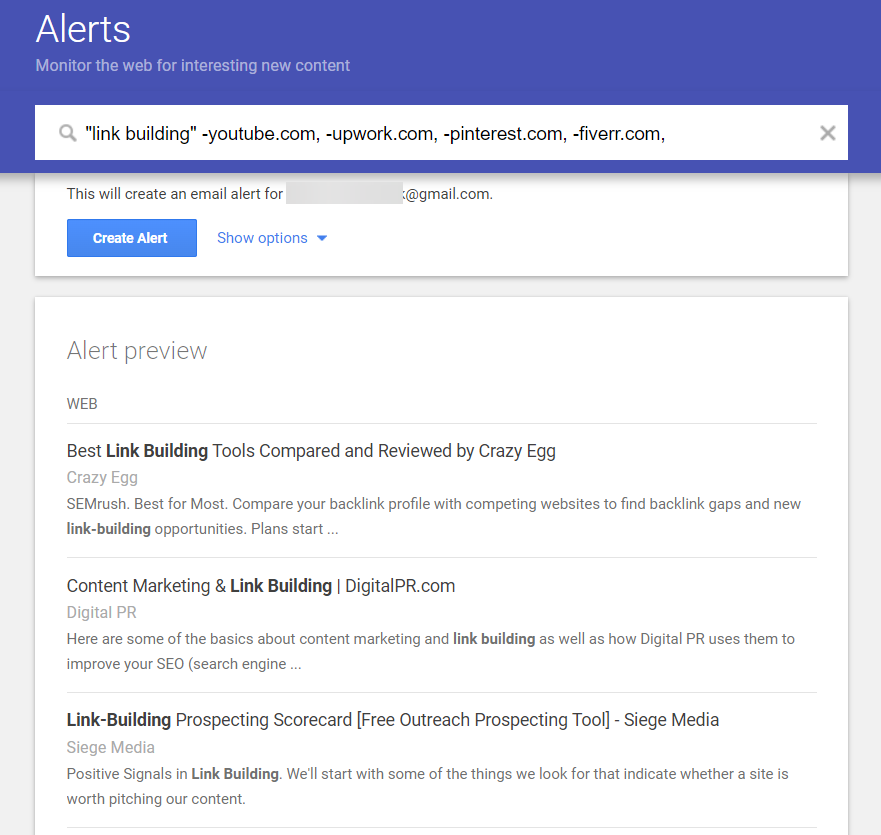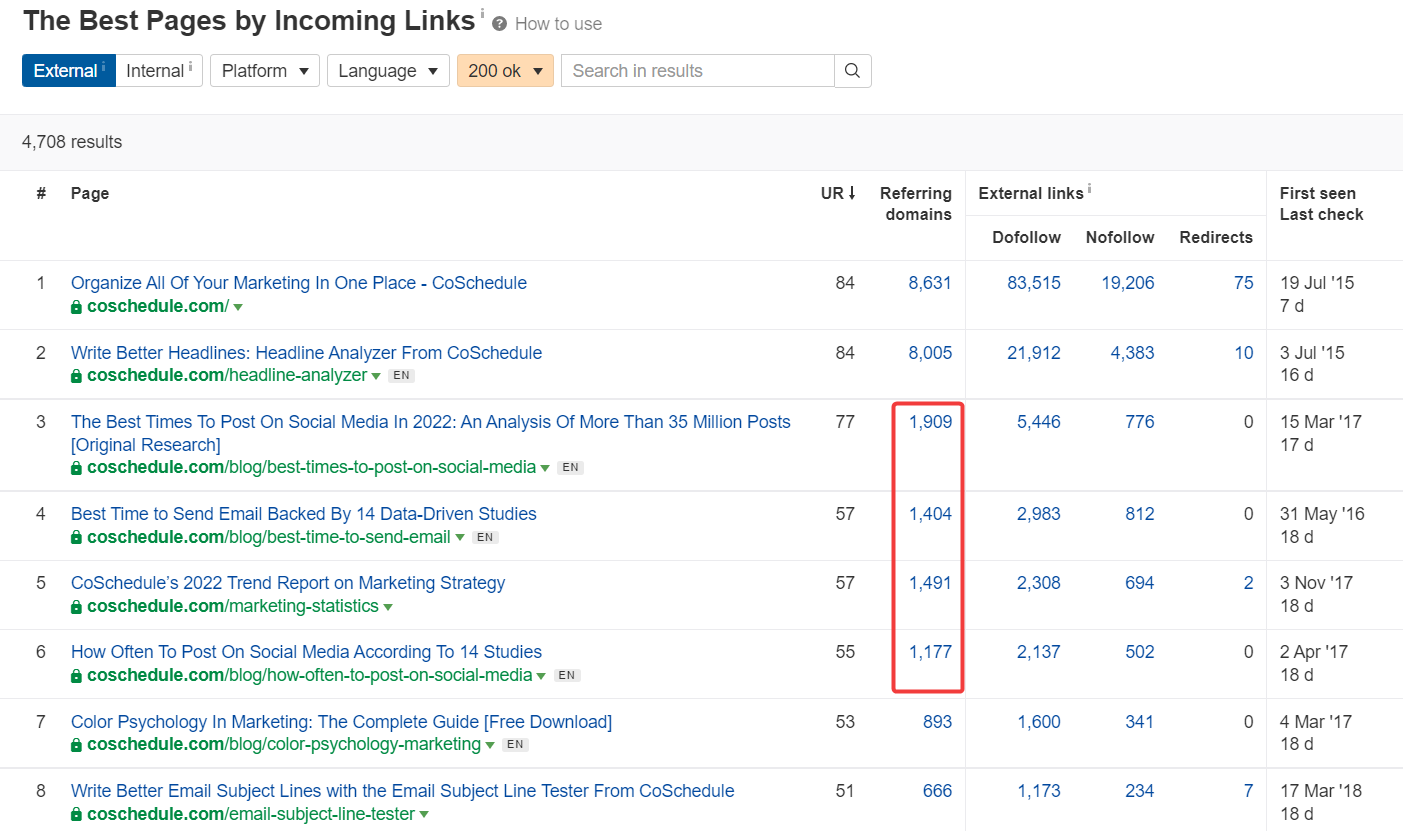With over 6 years of link building experience for B2B clients, we’ve tried and tested everything from classic outreach to niche edits to reverse image search, and so on.
We’ve seen how each tactic contributes to search rankings and whether the efforts pay off.
So if you’re looking for practical advice on link building, you’re in the right place.
In this piece, we’ve put together the 23 tried-and-true link building techniques with examples, so you can easily replicate any of them.
Let’s learn!
Strategy #1: Outreach
Blogger outreach is a classic tactic for acquiring high-quality backlinks and increasing domain authority (DA) over time. It’s one of the most time-consuming methods, though. On average, the response rate of a cold email is 8.8%. Imagine how much time you need to invest in getting just ten links, considering that not every response is a positive one.
However, there’s a smart shortcut.
Since cold email outreach is about finding niche relevant sites and pitching to webmasters (aka complete strangers), consider getting in touch with all of your connections first. This way, you can land hundreds of links in no time compared to traditional cold outreach.
1. Review your customers and partners
Open your CRM and export the contact information of clients and partners with corporate emails, social media links, domain links, and company names. Ask your marketing team to prepare the list of partners they collaborate with.
Select relevant outlets and start working on this list.
Here, it’s essential to pinpoint the importance of segmentation — there is no one-size-fits-all rule in email outreach.
"My best advice for outreach is to segment, segment, segment — you should hone down on who you are reaching out to and craft a script perfect for them and then personalize it. If you are creative and segment, you can write a personal email script that does not require hours of personalization." — Patrick Rice, SEO and content marketing expert.
2. Check out social connections
The best way to get first links is to reach out to somebody you’ve forged relationships with (or at least you’ve been following each other). Look through your LinkedIn, Twitter, and Facebook followers to find industry-related peers and offer them link building collaboration.
3. Harness the power of closed communities
You’ve probably seen or even been a member of private/open Facebook or LinkedIn professional communities (e.g., SEO pros, sales communities, UX designers, etc). So open the Members page of a group and go through the list of the members to find prospects for link exchange.
Or you can reach out to the folks that drive discussion in a group. They’re more likely to agree to partner up when it comes to link building.
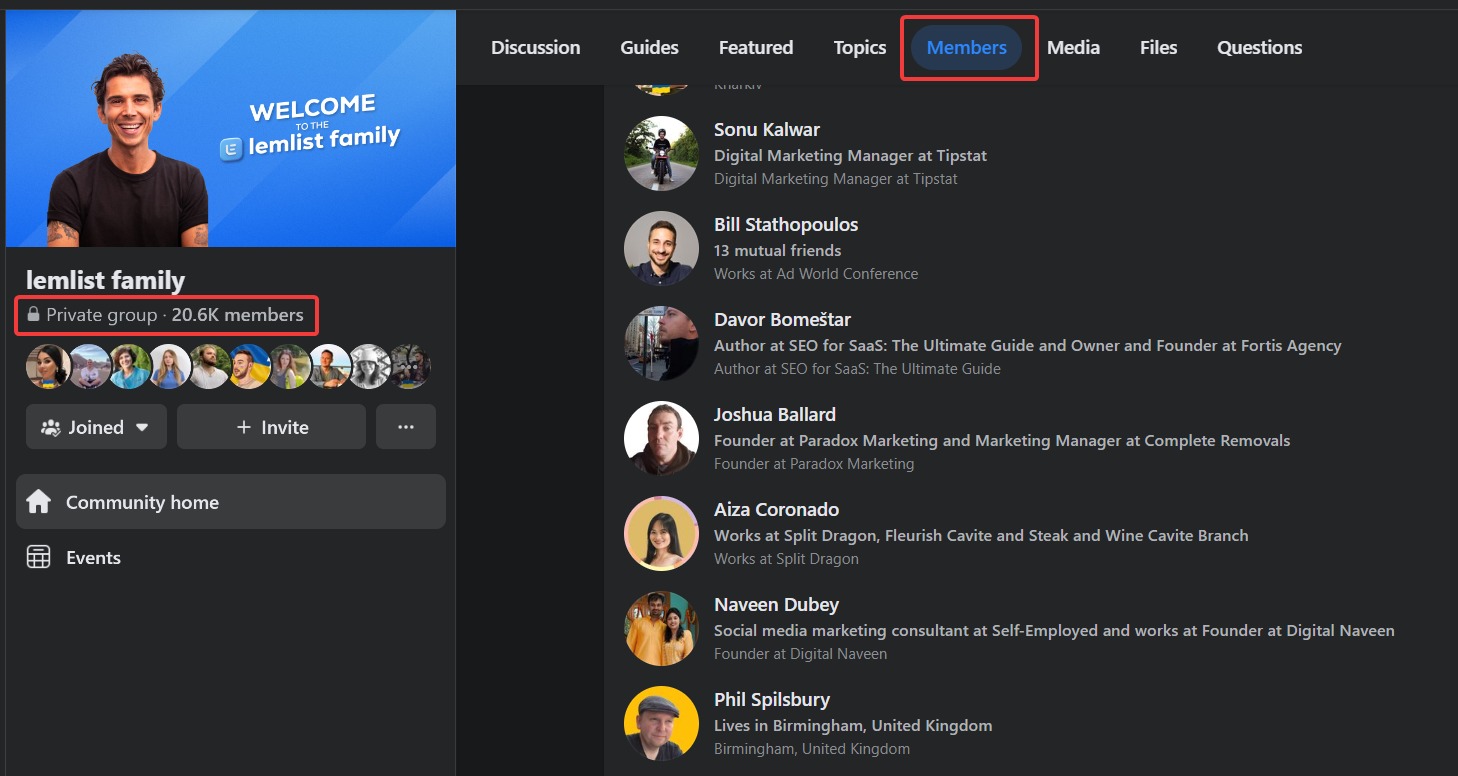
20K+ of link building opportunities in the sales industry!
Bottom line: Blogging outreach can work wonders and generate an abundance of links when done right.
Strategy #2: Broken Link Building
Broken links or dead links are pages that return a 404 page or don’t open at all. Imagine you’re reading a piece of content, and you see a hyperlink complementing the main idea. Having clicked on it, the page returns a «404 not found» error. Bummer.
As a reader, you’re upset about it. As a link builder, you see an opportunity.
In short, broken link building requires SEOs to find content pages that refer to broken links. Next, SEOs analyze what dead pages were about. You can do so with the Wayback machine. Lastly, decide whether you can write better content to convince webmasters to fix broken links and refer to your content instead.
We must say it — mediocre articles won’t work out. If you consider using this tactic, make sure you craft outstanding pieces that are worth a link back to.
 Ahrefs' homepage in 2019. A snapshot from the Wayback machine
Ahrefs' homepage in 2019. A snapshot from the Wayback machine
Strategy #3: Infographic Link Building
This strategy requires lots of work and doesn’t guarantee any backlinks. But when it’s done right, the chances are it goes viral and will generate links passively from top-notch outlets.
There’s no benchmark for the number of backlinks an infographic will generate, so we looked at ten B2B SaaS infographics and found some rough averages. We found that you can expect from 15−20 referring domains to hundreds
Apart from that, infographics are useful for increasing brand awareness and establishing brand authority.
Here’s how to turn an infographic into a linkable asset:
- Brainstorm an idea for an infographic based on the unique data set. This is crucial for a successful campaign. Top bloggers, influencers, and media outlets will mention your study only if it’s unique and backed up by data samples.
- Run a poll or a survey to collect as many data points as possible. Distribute the survey via email, social media, partners, personal social pages, etc.
- Analyze data and design a static or interactive infographic.
- Reach out to the industry thought leaders and influential peers to sneak a peek at the study results and share their thoughts on it. Embed quotes into the study description.
- Distribute your study through as many channels as possible: ask influencers to share it, and get it delivered to all your customers and prospects. Share with your partners. Find contacts of relevant journalists and get them to know about your study via cold outreach.
- Harvest referral and organic traffic and new backlinks.
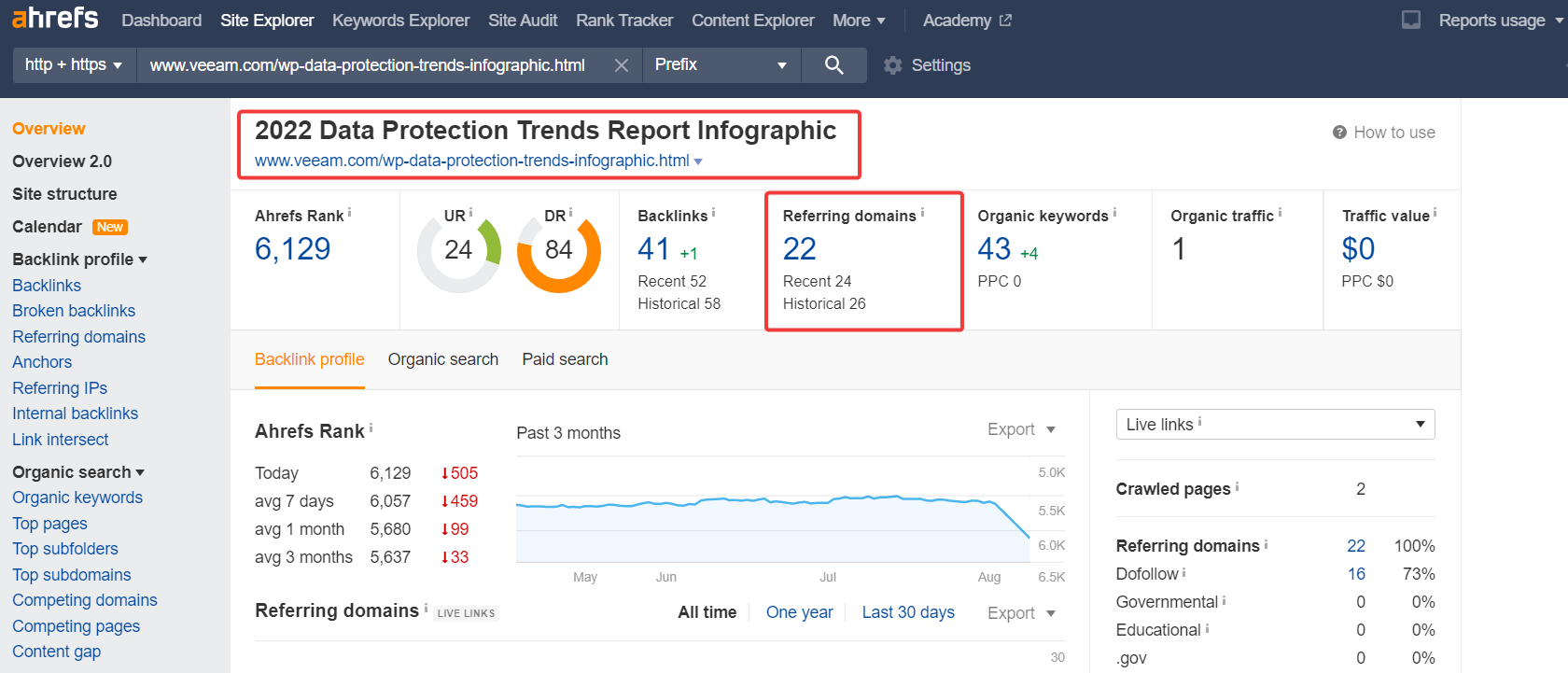
A quite simple infographic by Veeam has earned 22 unique links.
Strategy #4: Resource Pages
Resource pages or listicles are pieces of content in a list format — best SEO tools, best places to visit in California, places to learn 3D animation, etc. The aim of these pieces is to provide readers with credible and comprehensive information and facilitate their choice (or vary their options).
So how to gain backlinks from resource pages?
There are two tactics:
- Search for broken links in that list. If it describes over 20 or 30 resources, the chances are some of them are no longer accessible (i.e., a 404 error).
- Forget about broken links and prepare a short description of your services to include in the list. Tailor it to the resource’s format. Get in touch with webmasters and ask if they consider your resource valuable enough to link back to it.
Whatever strategy you choose, personalize your cold email sequence to stand out and melt webmasters' hearts. But don’t be pushy and intrusive.
Strategy #5: Unlinked Brand Mentions
If you are on the market for two or three years, people start talking about you. They can mention the brand in articles and share experiences of working with you, but they won’t always link back to your site. This is an opportunity to claim a link.
Here are three ways to find unlinked brand mentions:
- Use Google search operators. Type the following query into the search bar and analyze search results. Repeat this process every month.
intext:{brand name} -{website.com} -twitter.com -facebook.com -pinterest.com -youtube.com -linkedin.com -instagram.com -quora.com
- Use brand monitoring tools like Brand24 or Mention to find new mentions automatically. These tools crawl social media and the web 24/7 and report on the latest brand (or any keyword) mentions.
Hint: Set up monitoring for competitors and industry-leading projects and leverage their link building tactics.
- Set up Google Alerts to keep track of new brand mentions. Using this tool, you’ll see recent mentions of your brand name or any keyword you specify in the latest articles. Google Alerts works the same way as Brand24, but it requires manual setup, making it less convenient for large volumes of mentions.
Strategy #6: Directories (Trusted)
Directories are websites that list other webpages and offer the ability for webmasters to submit their own sites for inclusion. It’s important to vet directories before using them since low-quality directories won’t provide any SEO benefits or even harm ranking potential due to low domain authority, incorrect categorization, or too many outbound links. Here are some tips on how to vet quality directories:
- Check the domain authority of the directory. A higher domain authority indicates more trust and better rankings.
- Do some research on the amount of traffic it receives and look at reviews online.
- Look at how many external links there are per page and make sure they’re all relevant and trustworthy.
- Evaluate the categories—are they well organized and easy to navigate?
- Examine if there is any editorial control over accepting submissions, as well as moderation policies for keeping spam sites out of the directory listings.
Here is a list of trusted directories for link building in different categories:
- Yelp
- Yellow Pages
- Better Business Bureau
- AllTop
- Manta
- SuperPages
- YourLocalBizDirectory
- MerchantCircle
- Find-Us-Here.com
- CitySquares.com
Directories also help with bringing in referral traffic.
Strategy #7: Original Research and Data
While this tactic will get you sweaty, it might pay off big time in the long run. A single original data study can bring over 250−500 unique links and fill the sales pipeline with new prospects. On the other hand, you could only get a few links. You never know unless you try.
Like infographics, an original data study requires thorough initial research:
- What data do we own or are able to obtain?
- What questions do we want to answer?
- Why is it a useful study? What insights might we uncover?
- Who will benefit from it?
- What outlets would be interested in covering the results?
The main difference between an infographic and original research is how the data is collected and presented. Original studies analyze unique product data. For example, Ahrefs studies its backlink database and SERPs to find a correlation between rankings and backlinks.
Alternatively, you can survey a large number of experts (over 500−800 people) and draw conclusions from their responses.
"Creating survey-based content is a nice way of getting new data and such a piece can very much become evergreen. We’ve experienced our clients' surveys receiving links for years, as long as they are relevant, timely and looked after, they can carry on receiving links long after initial outreach has finished." — Hana Bednarova, founder at Shout Bravo.
To present research, there’s no need to create an infographic. Use simple graphs to make data more accessible and easier to understand and link back to it.
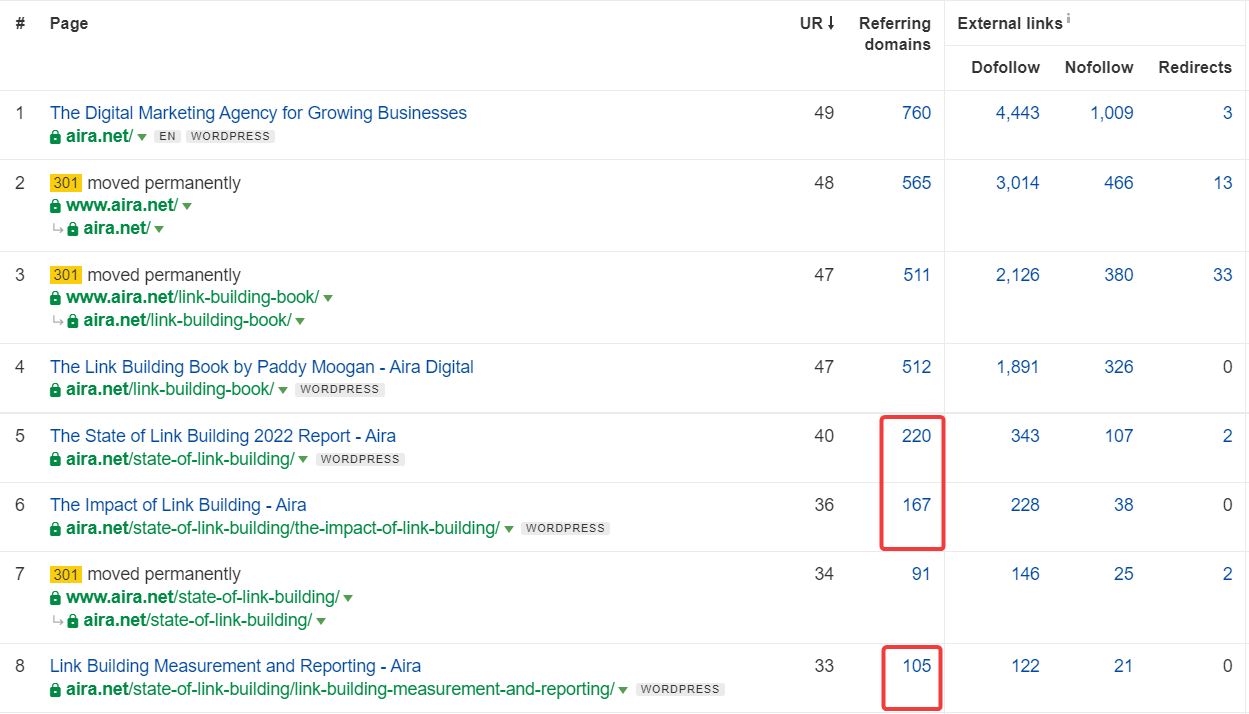 The digital marketing agency Aira has got over 550+ links in total from a single study placed onto different landing pages.
The digital marketing agency Aira has got over 550+ links in total from a single study placed onto different landing pages.
Strategy #8: HARO
HARO (or Help a reporter out) is a platform that connects journalists and reporters from different media with people like you and me. HARO’s idea is to make it easy for journalists to find the right people to interview for upcoming stories.
When starting out, HARO offers to choose topic categories, so you can get niche-related inquiries. This actually works because the number of daily requests is huge. Your inbox gets a laundry list of relevant requests twice a day, so you get to decide what to cover.
The following advice can help you sort through these requests faster:
Respond quickly. HARO sends 3 emails per day at the same time, every day. I prioritize time to read through the emails and make sure I reply quickly.
Relevance. I only respond to relevant queries. It takes 60 seconds to read through each email, and I can quickly decide which queries are relevant for me. If it’s not relevant, I move on.
Experience. Once I’ve found a relevant query, I’ll respond and share real-world experience that includes my own data. Not only does this help make my response stand out, but it also makes it unique (and more likely to be featured)." — Steven MacDonald, Head of Content at Inevo.
However, you’re not the only one who receives requests, so competition for being featured on Forbes, Business Insider, CNN, etc., is fierce. To win the spotlight, you need to submit a meaningful, comprehensive answer.
Also, working with HARO doesn’t guarantee a steady and controlled link flow. It’s more like gambling. Still, HARO helps link builders get juicy links.
Strategy #9: Niche Edits
Niche editing is very similar to broken link building and the Skyscraper technique. You’re looking for niche-related websites and asking their owners to swap links with yours. Note, you ask to replace a working link.
Why would webmasters do so? Well, it’s either about monetization (you'll pay for link exchanges) or high-quality content. If you can beat the quality of the piece they’ve linked to, the chances are someone will consider linking to it. This is a so-called Skyscraper method, and it has a place in B2B.
When it comes to rewards for swiping links under specific keywords, it’s niche edits. This approach may work for niches such as lifestyle, diets, entertainment, etc. Swapping links, however, violates Google Webmaster Guidelines.
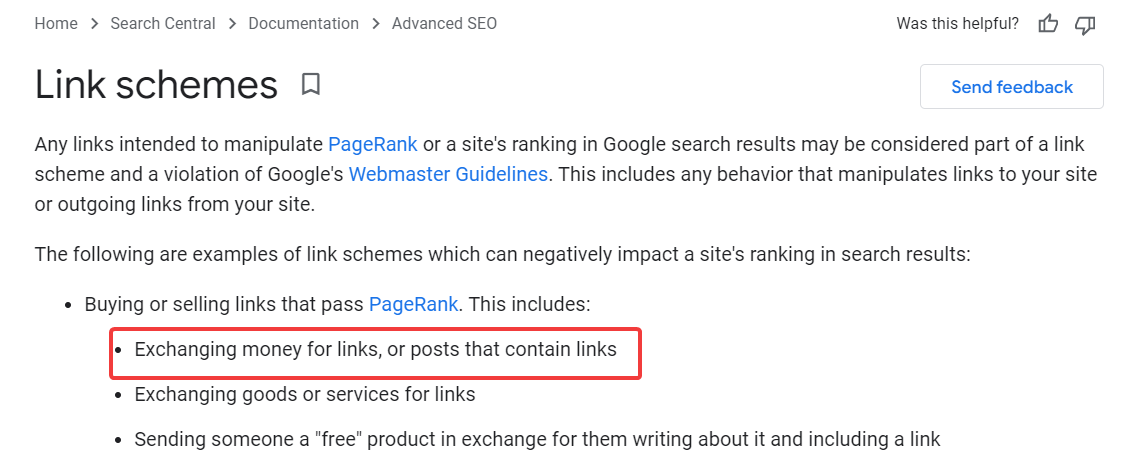 Google Webmaster Guidelines, Link schemes
Google Webmaster Guidelines, Link schemes
Strategy #10: Roundups
Roundups serve as a foundation for future content and link building collaborations. If you’re new to the niche, you need to network in order to get eyeballs on you and your business. One of the easiest ways to connect with industry folks is to make a move first (i.e., bring them value).
«It should be a rule to never post a blog post without at least one guest quote contributor. It increases your network, could provide an opportunity for guest posting down the line through the reciprocity effect, and increases social share visibility.» — Clint Mally, Director of Marketing at Sandstone Care.
With time, you can approach them with content collaboration ideas, guest posting, or ask them to introduce you to someone from their network.
If you see someone running a data survey or announcing upcoming original research, reach out to them to comment on the findings. This way, you can also get a link and be featured in a roundup.
Strategy #11: Testimonials
Testimonials can bring up to 10−20+ links. It directly correlates with the number of solutions you use across different teams. Examples include CRMs, email automation tools, data scrapers, project management tools, API connectors, a marketing toolkit, etc.
List all the tools your team uses regularly. Contact a personal manager or support chat and offer them feedback. This way you will get links with little effort.
Strategy #12: Reverse Image Search
This tactic works like magic and isn’t overused. That’s especially true if you make cool data studies, infographics, and other unique visual content people like to cite (or steal?). So, what’s the deal?
Imagine you’ve created original research with unique stats and put the numbers on graphs or visualized it another way. The piece went viral or reached high rankings in SERPs. As a result, some outlets have started linking back to it.
Make sure everyone who uses your data in their pieces gives you credit (i.e., link to you).
To find unauthorized uses of your visuals, use reverse image search (Google or Bing image search). Here’s how:
- For Chrome users, right-click on the image and choose «Search image with Google Lens.»
- Paste the URL of the image in Google Images and run the search.
- Upload an image (infographics, charts) to Google Images.
Found outlets that ignore copyright policies? Contact webmasters and ask them to link to you.
 Reverse image search with Google Lens
Reverse image search with Google Lens
Strategy #13: Surveys
Surveys are a part of the digital PR strategies with a prime goal to get the brand featured on top media outlets and get eyeballs on it. When done right, it might bring tons of backlinks too as everyone who wants to refer to your survey results has to link back to you.
OrbitMedia’s blogger survey is an example of a successful survey used to gain links. The piece has acquired 3,427 links, making it the most linked-to page of the site.

Surveys can become the passive source of relevant links
Strategy #14: Link Reclamation
In short, link reclamation is when a website reclaims back backlinks that it lost. For instance, the page was removed, the link was removed, or the linking page gets (301) redirected. So, you want your links back and justice to be served.
Linkody, a backlink monitoring tool, will help you to catch lost backlinks. It tracks new quality and malicious backlinks, removed links, or the change of a link status (dofollow to nofollow links). Get instantly notified about any change across your backlink profile and react accordingly.
Ahrefs will also be useful. If you want to monitor lost links, say one time per month, follow these steps:
- Open the Legacy — Backlinks — Lost report
- Establish the date range for searching lost links
- Filter dofollow links (we suggest doing so as dofollow links are of top priority)
- Sort by DR
Thus you form a report with lost fat links you want to get back.
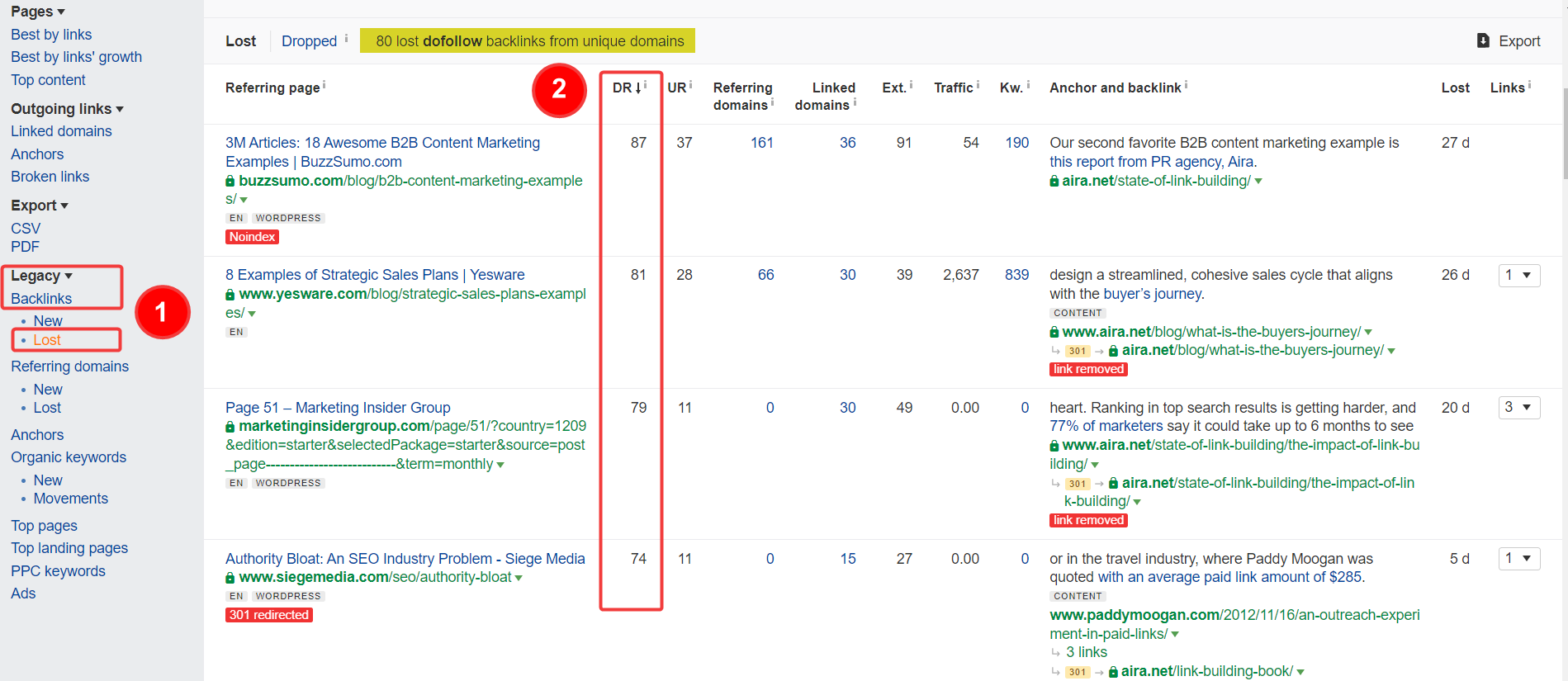 How to find lost backlinks with Ahrefs
How to find lost backlinks with Ahrefs
Strategy #15: Competitor Backlinks
Spy on competitors and other relevant websites to leverage the same outlets for placing links. Plus, understand the context in which webmasters will allow you to link back.
With Ahrefs, you can manually analyze new and past competitors' referring domains. Linkody will monitor new competitors' links automatically and notify via email once new links emerge.
Next, you get to decide what way you want to earn a link from those sites. You can either outreach outlets and offer them new pieces of content, or you can act craftier and ask website owners to replace a competitor’s backlink with yours (i.e., make use of the Skyscraper technique).
Strategy #16: Reverse Guest Blogging
Most link builders know about guest blogging, where you get bloggers to publish an article on their sites. Reverse guest blogging is the opposite. You ask a blogger or a well-known figure in your industry to write a guest post on your blog.
Why do so? Like with roundups, this is the way to form friendly relationships with webmasters/bloggers. This strategy doesn’t directly guarantee any backlinks, but there’s a high possibility that the guest blogger will link back to your site in their upcoming pieces.
There’s also a chance that the blogger’s fans will link to the article.
Strategy #17: Get Interviewed
This technique works great for SaaS and B2B companies. People from the B2B industry love networking and learning from others' ups and downs. If CEOs or execs get interviewed, such stories are bound to get high engagement on LinkedIn or Twitter.
How to leverage interviews in link building?
You can offer this type of content when outreaching, instead of a banal «how-to». The chances are you’ll get a higher response rate.
For example, you can share a story of «How company X grew to 3,000 customers in 3 months» or «How to run a successful Facebook community and generate leads [Examples included].» Be sure to mention in your outreach email that you’ll insert your own stats and strategies. This should spark the editor’s curiosity.
Strategy #18: Link Repositioning
Link repositioning is not about building new links but changing the positioning of old (current) backlinks. Here’s how it works. Usually, a website’s home page attracts the most backlinks. However, you’d like to pass some link juice to landing pages.
To do so, find backlinks that point to the homepage but could be pointing to the page you need. Next, ask webmasters (via email outreach) to link to that page.
Here’s how to find quality links for repositioning:
- Open Ahrefs and paste the URL to the homepage. Choose «Exact URL».
- Set up a filter: dofollow links found in content. Like this, Ahrefs lists backlinks pointed from content pieces.
- Sort links by DR.
- Analyze the text surrounding anchor text and select relevant pages for link repositioning.
 How to find web pages for link repositioning with Ahrefs
How to find web pages for link repositioning with Ahrefs
Strategy #19: Ego Bait
Ego bait is a tactic for building relationships with top-notch outlets, editors, influencers, etc. It won’t bring immediate high-quality links but will serve to establish long-term collaborations leading to big, fat links.
In essence, ego bait is a piece of content in which you mention certain people/brands in order to get on their radars. If you continue engaging with their content, ask questions, and bring value (e.g., a couple of more links), they will start linking back to you for the sake of balance in the Universe. Jokes aside, human relationships indeed work this way.
Examples of ego bait content include:
- Listicles
- Roundups
- Opinionated content
- Awards
- Interviews
Strategy #20: Create Linkable Assets
Linkable assets are content types that can generate backlinks passively. Such content includes statistics, articles, free tools, free templates, and original case studies. To exemplify, the CoSchedule team creates outstanding linkable assets — four original studies have brought 5,981 referring domains so far! Would it be possible to reach this height with email outreach or any other link building methods in a couple of years? Definitely not.
Does it necessarily mean you’ll have the same results if you publish a linkable asset? Unfortunately, it doesn’t. As with everything in content marketing, it depends. The topic, the search intent, the content design, the pre-distribution strategy, and the distribution strategy all play a role.
On average, it takes one to three months to produce a linkable asset — from ideation to distribution. But this method is obviously worth a shot. If done right, you’ll get an abundant number of links along with referral traffic and prospects.
Before undertaking such a project, we recommend you check out the free Digital PR course by Semrush & Brian Dean. You’ll walk through every necessary step of creating linkable assets.
This was the last «white hat» tactic for acquiring great links and boosting website rankings. Now, let’s talk about the 3 «black hat» methods of getting links. Get to know them, but don’t use them.
3 Black Hat Link Building Tactics to Avoid
«Black Hat» link building refers to acquiring good links in a decisive manner in order to manipulate search engine results. It is forbidden by Google to use any of these methods, and if you do, you may receive a penalty and lose rankings as a consequence.
Let’s get familiar with the three common «black hat» tactics to avoid.
1. Paid links
Buying links is against Google’s guidelines. Paid links are way, way faster than «white hat» links, but they can get a website penalized. First of all, there are no high authority domains (real companies) that would offer you to buy a link. It’s scandalous for corporate blogs and respectable outlets. So you will end up paying for links from spammy and questionable sources that were designed specifically for this type of monetization.
Another way is to buy over freelance writers and regular contributors to relevant sites and offer them monetary rewards in exchange for links. It might seem a good deal on the surface, but you never know who might report you to Google for breaking their rules.
As a result, it will cost you more time and money to recover your site than to reap the benefits of such manipulation.
2. Aggressive reciprocal links
If you’re reaching out to webmasters to offer them a link on site X in exchange for getting a link from their site, this is a reciprocal link. In essence, reciprocal links are a byproduct of healthy networking. In fact, 73.6% of sites do have reciprocal dofollow links. But the average overlap is only 15%.
When you exchange links aggressively, Google may notice it and penalize the site because reciprocal links are also against Google guidelines.
3. PBNs (Private blog networks)
PBNs refer to a group of sites within one niche built for pointing links to the main site to improve its rankings. For example, if you own an online shop for pet food, you’d build hundreds of blogs about pet care to link back to the shop.
The tactic violates Google guidelines and may result in all of the sites being restricted.
Bonus: 3 Creative Link Building Tactics
Here we’ve listed the three unpopular but fruitful «white hat» link building tactics.
Tactic #1: Offer SEO value
This method is about hyper-personalized outreach with an SEO value inside. So how does it work?
First, find a relevant blog or website to get a link from. Then, do keyword research for it to find a good topic that the website misses or a topic that its competitors rank for, but a target domain doesn’t.
Lastly, reach out to the site and offer to create new content for them around that topic (or present a list of such topics). Make sure to mention that you’ve done keyword research and that the piece 100% matches the target audience and will be SEO-optimized.
By going the extra mile, you’ll make your pitch hard to ignore.
Tactic #2: Use social media groups to gather data and forge relationships
Link builders use social media for two purposes. The first one serves to help the «survey» link building strategy we mentioned earlier. The link builder posts a survey on relevant social media groups and then with the results creates great content that outreach to journalists or bloggers.
The second purpose is to establish relationships with like-minded link builders and niche-related peers for further content and link building collaborations.
Tactic #3: Coin a new term
This is what Backlinko’s Brian Dean did with the «Skyscraper technique.» Brian invented the term and threw it in the wild. You can do the same. How? Spend some time thinking about which parts of your job you or your colleagues make up names for. It can be a short form of concrete actions or a made-up name like the Skyscraper technique.
Then include this term in articles, social media posts, podcasts, etc. The goal is to get the network to use a new term too.
It’s a slow tactic that works mostly for well-known sites/brands in their industry but can be effective in the long term.
Now Over to You
Link building is getting harder. On the one hand, people are overwhelmed with spammy cold emails, so they don’t respond to outreach anymore unless it’s super personalized (the #1 creative tactic in the previous chapter).
On the other hand, Google rolls out updates every quarter that get SEOs to deliver more valuable content. Meaning you get to put more effort into writing authentic pieces and overall link building campaigns.
Use the 23 listed tactics wisely. Test them all to find out what works best for your niche. Or get in contact with our team and start getting links from the first month.



